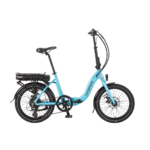Back in 1959 our physics teacher taught us how a bike pump works . Two valves are involved . The piston washer acts as one valve , letting air from the atmosphere into the pump cylinder , and preventing it from escaping back to the atmosphere . The inner tube valve allows air to flow from the pump cylinder into the tube , but not back out again . The valves in those days were I believe called Woods valves , and had a replaceable rubber sleeve . Then along came the Schrader or car type valve . No problem , you just buy a new pump connector . Except that it does not work . Your new connector has a pin inside it that depresses the valve core , thus keeping it permanently open , and preventing it acting as a valve . As you push in the pump handle , it puts air into the tube . As you pull the handle out again , the air flows from the tube back into the pump . Indeed if there is already some air in the tube , you will not need to pull the handle out , it will come out all on its own . You can stand there all day , and it is fine exercise , but you will still have a flat tyre . I have asked bike mechanics ,and tyre fitters . No one has the answer . Isn`t progress a wonderful thing .
Question without an answer .
- Thread starter neptune
- Start date
Answer from this fully qualified mechanic:
That only happens when the connector is pushed on too far, or if a screw-on connector, it's incorrectly designed. Correctly connected, the valve stays closed and only opens under air pressure from the pump, thus acting one way only.
If that were not the case, the integral gauges on some pumps could not show the pressure after a pump stroke until the pump piston had fully extended again.
P.S. If the rubber washer is missing from inside a screw-on connector, back flow can happen then, since it can then screw on too far. It's also important that the Schrader valve core is fully screwed in.
.
That only happens when the connector is pushed on too far, or if a screw-on connector, it's incorrectly designed. Correctly connected, the valve stays closed and only opens under air pressure from the pump, thus acting one way only.
If that were not the case, the integral gauges on some pumps could not show the pressure after a pump stroke until the pump piston had fully extended again.
P.S. If the rubber washer is missing from inside a screw-on connector, back flow can happen then, since it can then screw on too far. It's also important that the Schrader valve core is fully screwed in.
.
Last edited:
Hi Flecc , and many thanks for that reply . This all started after I bought a pump , with Schrader connector from Wilco . I had just bought my first bike with Schrader valves . It would not work , so I bought a new connector from a market stall . same problem . Bought yet another connector off Ebay . Same problem. Tried all these connectors on the tyres of my van . Same problem . Then I bought a cheap pump off the market that fits straight on to the valve without a connector . Problem solved . The only way I could use the Wilko pump was to attach it very loosely to the valve , but then most of your effort was wasted due to escaping air .
The only pump I owned with an integral gauge was a foot pump , which works of course on the same principle . I always assumed that there was an extra valve between the pump cylinder and the gauge , but as I never stripped it , I am not sure . If I am right , then in this case the tyre valve connector WOULD need to open the valve for the guage to give a true reading .As I say , I overcame the problem by getting a different type of pump, but years later it still bothers me !
The only pump I owned with an integral gauge was a foot pump , which works of course on the same principle . I always assumed that there was an extra valve between the pump cylinder and the gauge , but as I never stripped it , I am not sure . If I am right , then in this case the tyre valve connector WOULD need to open the valve for the guage to give a true reading .As I say , I overcame the problem by getting a different type of pump, but years later it still bothers me !
That's not always the full story.....
Many Schrader connectors do actually press the valve core to open it - but if they do, there's a non-return valve built into the connector itself or in the body of the pump. My (standard el-cheapo) bike pump works that way.
Do make sure that there's a washer in the connector where you screw it onto the valve. If there isn't you won't (obviously) get a seal and air will escape. The same applies if it's not screwed tight enough onto the valve stem.
The only pump connector which definitely won't normally have a non-return valve but does press on the valve core to open it is the type where you have a gauge - in this case, there is a non-return valve but it's located between the gauge and the pump, not in the connector. This applies to all electric tyre pumps which always have a gauge for safety reasons. It's obvious if you think about it that a gauge can't indicate the pressure in the tyre unless the Schrader is open.
Rog.
Many Schrader connectors do actually press the valve core to open it - but if they do, there's a non-return valve built into the connector itself or in the body of the pump. My (standard el-cheapo) bike pump works that way.
Do make sure that there's a washer in the connector where you screw it onto the valve. If there isn't you won't (obviously) get a seal and air will escape. The same applies if it's not screwed tight enough onto the valve stem.
The only pump connector which definitely won't normally have a non-return valve but does press on the valve core to open it is the type where you have a gauge - in this case, there is a non-return valve but it's located between the gauge and the pump, not in the connector. This applies to all electric tyre pumps which always have a gauge for safety reasons. It's obvious if you think about it that a gauge can't indicate the pressure in the tyre unless the Schrader is open.
Rog.
Last edited:
Certainly a badly designed connector can do that, and any push on connector too far in gives the same annoying result. There isn't usually a lower valve in pumps, the tube/tubeless valve performs that function. When pumping stops, the pressure equalises between pump cylinder and tyre and back pressure into the pump commences. That drives the Schrader valve insert closed and any integral gauge then reads the correct pressure.
N.B. Crossed with Rog's post.
.
N.B. Crossed with Rog's post.
.
Last edited:
This thread prompted me to list my pumps.
A stirrup pump and an electric pump, both with gauges so dual valved of course
A bike mount track pump and a second stirrup pump without gauges both back pressure if the connector is pushed on too far, so no lower valves in those.
CO2 pump has no connecting centre pin so is also a valveless back pressure type.
A stirrup pump and an electric pump, both with gauges so dual valved of course
A bike mount track pump and a second stirrup pump without gauges both back pressure if the connector is pushed on too far, so no lower valves in those.
CO2 pump has no connecting centre pin so is also a valveless back pressure type.
D
Deleted member 4366
Guest
Is it possible that the valve in question (the one in the inner tube) is not properly screwed into its sleeve, leaving the pin too high for the pump?
It is always satisfying to receive several replies to a posting , it is useful to have different viewpoints and opinions .Out of curiosity , I just got out one of the connectors in question . It has a center pin to open the valve , and a rubber or plastic washer inside . I screwed it on to my bike valve without a pump .I tightened it reasonably tight with my fingers , and it promptly deflated the tube . If there is a valve inside it , it is not very effective . I carry a pump on my bike , which is the short telescopic type that fits onto the valve with no connector . Not brilliant , but a get-you-home device . At home I use a cheap car type 12 volt compressor , powered by an old car battery which I keep charged in the shed . It has a gauge , and no center pin in the connector . It works brilliantly .
I have not checked the tyre valve core for tightness , but have had the same results on every tyre tested .
I have not checked the tyre valve core for tightness , but have had the same results on every tyre tested .
Almost certainly that's the type which requires a non-return valve in the pump....I just got out one of the connectors in question . It has a center pin to open the valve , and a rubber or plastic washer inside . I screwed it on to my bike valve without a pump .I tightened it reasonably tight with my fingers , and it promptly deflated the tube .
Incidentally, there's a good reason for using the type which opens the Schrader. That valve has a spring built in to the core which closes the valve unless there's enough differential pressure from the pump to exceed the pressure already in the tyre by a significant amount. It takes more effort than you might think to open a Schrader by pressure alone, because although it's not a strong spring the effective area of the valve seat is tiny and so the few ounces needed to compress the spring can translate to quite a few pounds per square inch of 'real' pressure from the pump. When a pump has a non-return valve built in this usually takes the form of a small captive ball bearing which blocks the hole to the pump and creates no significant additional pressure to add to your effort.
The 'high pressure' Presta valve doesn't have a spring - once you unscrew the locking barrel it's only the air in the tube which keeps it shut - and that means it's more efficient from your point of view when you're pumping up the tyre.
Rog.
Quote from Rog "That is almost certainly the type of connector that requires a valve in the pump ." That sounds logical , except that the pump it came with[from Wilko] has no such valve . I checked at the local store to ask how many pumps they had had returned . The answer was none .Years ago , it used to be allowed to buy stuff from the local dump . Everyday , you could find 6 reasonable bikes that were in working order except the chain was rusty , and the tyres were flat . For the first time , I am starting to understand why...
Interesting. I just took a look at the cheap made-in-France Schrader pump (I think it came from Halfords many moons ago) on my MTB and that has a non-return valve in the connector at the end which screws in to the pump body. It's obviously either a captive ball or a sliding rod - you can hear it close but there's no spring involved.Quote from Rog "That is almost certainly the type of connector that requires a valve in the pump ." That sounds logical , except that the pump it came with[from Wilko] has no such valve . I checked at the local store to ask how many pumps they had had returned . The answer was none .Years ago , it used to be allowed to buy stuff from the local dump . Everyday , you could find 6 reasonable bikes that were in working order except the chain was rusty , and the tyres were flat . For the first time , I am starting to understand why...
I generally use a 12 volt pump also a few years old from Argos, and that has a pin to open a Schrader. If I don't push it well on so the pin does its job it makes significantly harder work out of inflating the tyre.
I wonder whether you might have been unlucky and got the wrong connector with the wrong pump?
Rog.
This is why I prefer a track or CO2 pump on a bike and a stirrup pump at home. They make light of that extra effort needed, compared with traditional bike pumps. I don't detect any difference in my two stirrup pumps, one unvalved and one valved with gauge (same type otherwise), so don't think any difference severe.Incidentally, there's a good reason for using the type which opens the Schrader. - - - - - - - It takes more effort than you might think to open a Schrader by pressure alone, because although it's not a strong spring the effective area of the valve seat is tiny and so the few ounces needed to compress the spring can translate to quite a few pounds per square inch of 'real' pressure from the pump.
The 'high pressure' Presta valve doesn't have a spring - once you unscrew the locking barrel it's only the air in the tube which keeps it shut - and that means it's more efficient from your point of view when you're pumping up the tyre.
Rog.
Efficient though they may be, I dislike Presta valves and swap to Schrader at the first opportunity, drilling out the rims. Connectors for Presta are often fiddly, not performing well, and the valve insert stems are frail. The universal nature of the Schrader gives so much more flexibility in pumping options.
.
Last edited:
Related Articles
-
 MTF Enterprises announces acquisition of EMU Electric Bikes
MTF Enterprises announces acquisition of EMU Electric Bikes- Started by: Pedelecs
-
 Wisper 806T folding bike wins Which? ‘Best Buy’
Wisper 806T folding bike wins Which? ‘Best Buy’- Started by: Pedelecs
-
 Sustrans calls for protected cycle lanes
Sustrans calls for protected cycle lanes- Started by: Pedelecs
-
 Amazon launch their first UK e-cargo micromobility hub
Amazon launch their first UK e-cargo micromobility hub- Started by: Pedelecs


